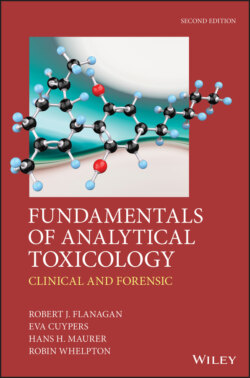Читать книгу Fundamentals of Analytical Toxicology - Robin Whelpton - Страница 20
1.2.2 Systematic toxicological analysis
ОглавлениеThe problem in systematic toxicological analysis (STA, poisons screening, drug screening, unknown screening) is to detect reliably as wide a range of compounds as possible in as little sample (plasma/serum/whole blood, urine, vitreous humour, stomach contents or vomit, or tissues) as possible at high sensitivity, but with no false positives (Maurer, 1999). Ideally some sample should be left to permit confirmation of the results using another technique and if indicated quantitation of any poison(s) present to aid clinical interpretation of the results.
In poisons screening it is important to adopt a systematic approach in order to eliminate possible contenders and to ‘home in’ on any compound(s) of interest present. STA can be divided into three key stages (Figure 1.1). The aim of the sample preparation step is to retain all the toxicologically important substances whilst removing potentially interfering sample matrix components. Thus, a wide range of analytes of interest, including lipophilic and polar, acidic, basic, and neutral species, should be isolated. To increase the yield of analyte(s) when analyzing urine, for example, the sample may be treated with β-glucuronidase/arylsulfatase to hydrolyze conjugated metabolites, but this may not be necessary if the conjugates themselves can be detected.
Figure 1.1 The three key steps in systematic toxicological analysis
The aim of the differentiation/detection step is to identify all relevant compounds in the minimum amount of time. This requires a combination of relatively non-specific (‘universal’) assays and highly selective methods. Immunoassays, particularly if the antibody has wide cross-reactivity, are useful for identifying classes of drugs. TLC has the advantage that all the non-volatile materials in the extract remain on the plate, whereas with GC and LC there is always the possibility that compounds have not been eluted from the analytical column. Obviously, one analytical technique cannot separate and identify all the possible compounds of interest. Only a finite number of compounds can be resolved on a single TLC plate, for example.
The greater the number and range of techniques that are available, the greater the probability that unknown substance(s) will be identified correctly. Investigation of the responses of various analytes to different detectors can provide valuable information about the nature of a compound. LC with diode array detection (LC-DAD) can provide spectral information to aid peak assignment, but is limited by relatively poor sensitivity and selectivity (Section 10.3.1). In contrast, hyphenated techniques such as GC-MS can provide robust analyte identification, particularly when combined with computerized libraries of electron ionization (EI) fragmentation data that can be searched rapidly to confirm compound identity (Grapp et al., 2016). In addition, positive ion chemical ionization (PCI) MS can be used to give an indication of the molar mass of a substance (Section 13.3.1.2).
Analytes may be chemically modified to improve their chromatographic properties or ‘detectability’, but derivatization can also give useful qualitative information. One classic example is the so called ‘acetone-shift’ (reaction of acetone with a primary amine to give the corresponding Schiff's base). Amfetamine, for example, reacts with acetone to form N-(1-methyl-2-phenylethyl)propanimine (Figure 1.2). If the product does not chromatograph as expected, then the unknown substance was not amfetamine.
Figure 1.2 Reaction of amfetamine with acetone
The third step in STA is to compare the observed data with validated database information. Clearly, databases used in compound identification need to be regularly updated, and must include information on not only parent compounds, but also metabolites, common interferences, and possible contaminants. It is important that the analytical techniques used in establishing such databases are reproducible, both within and between laboratories.
